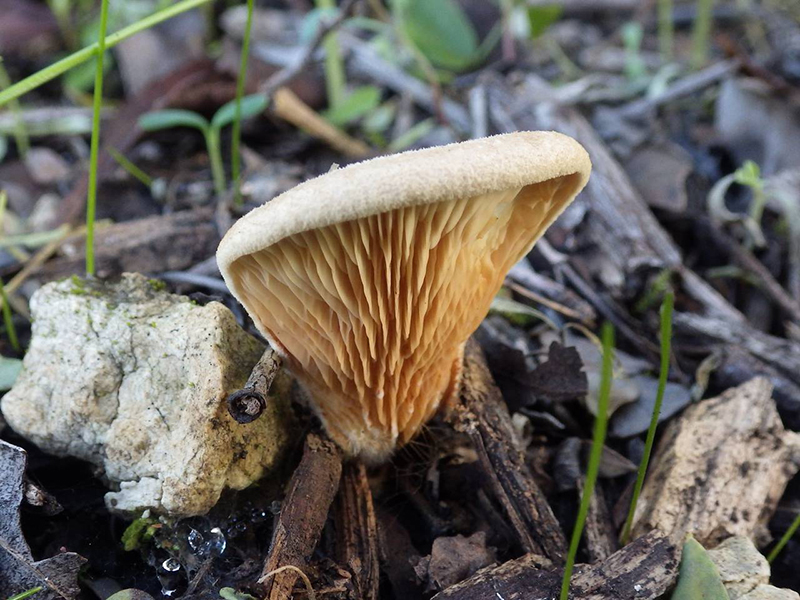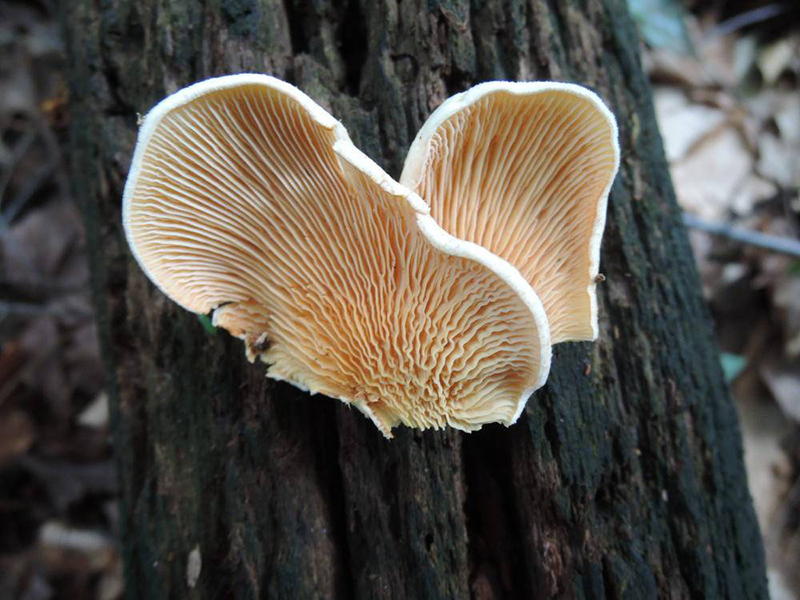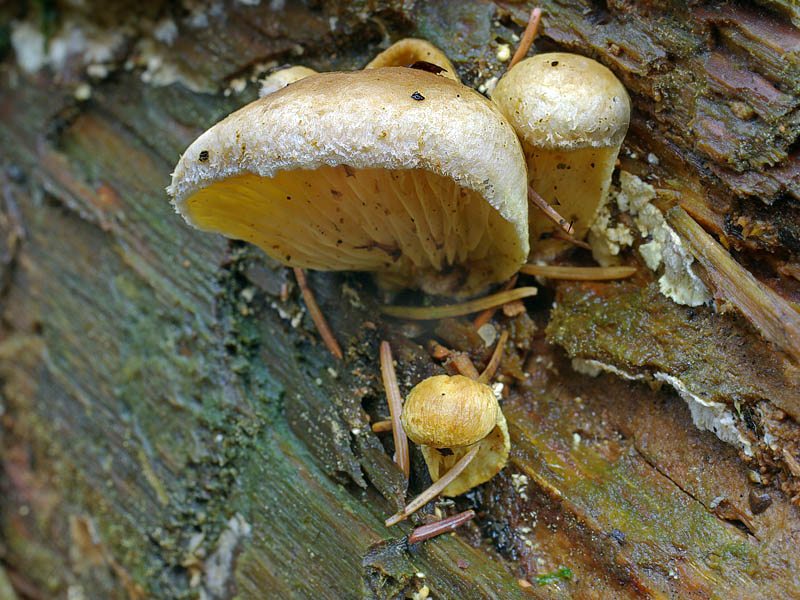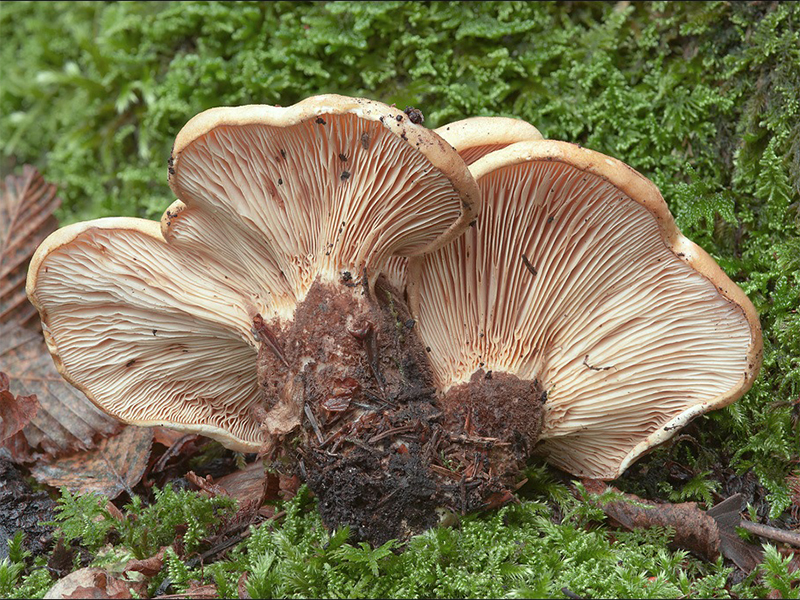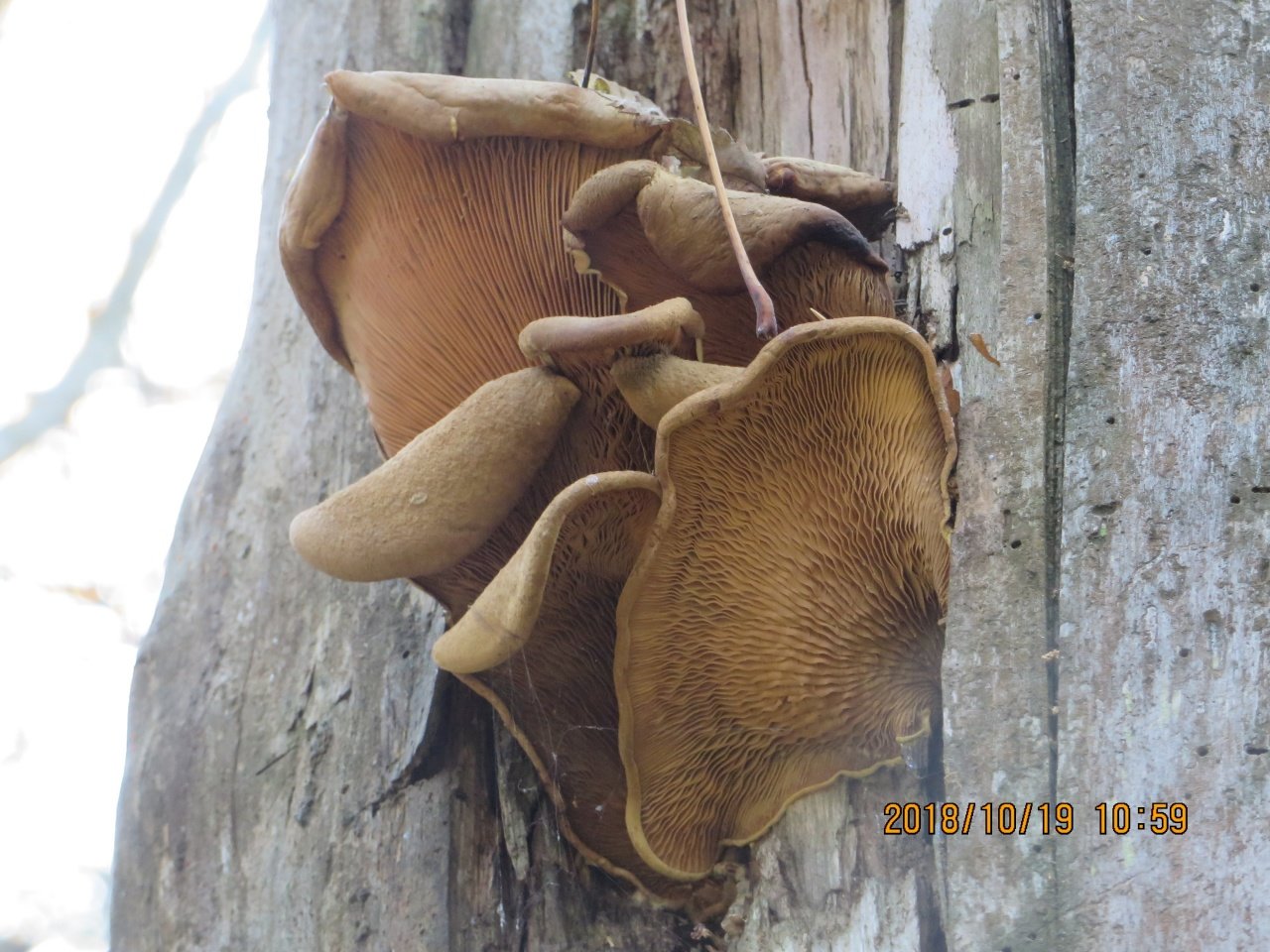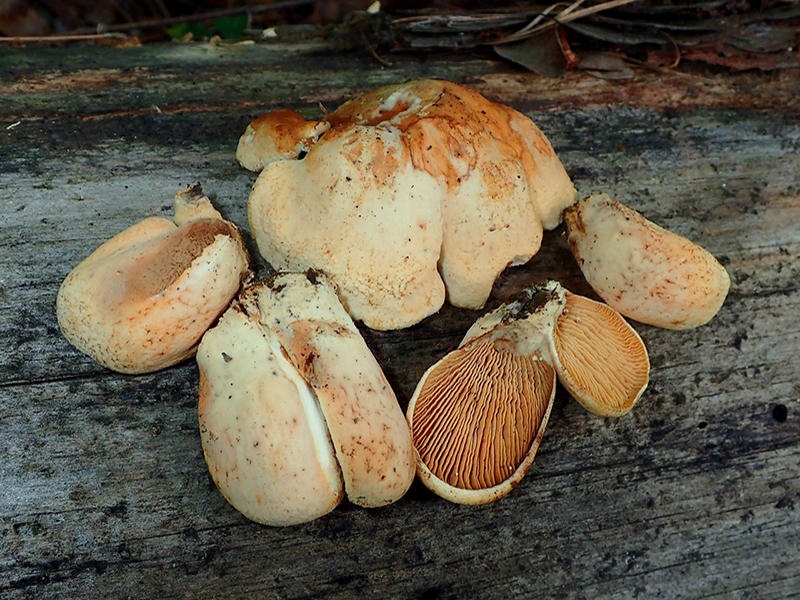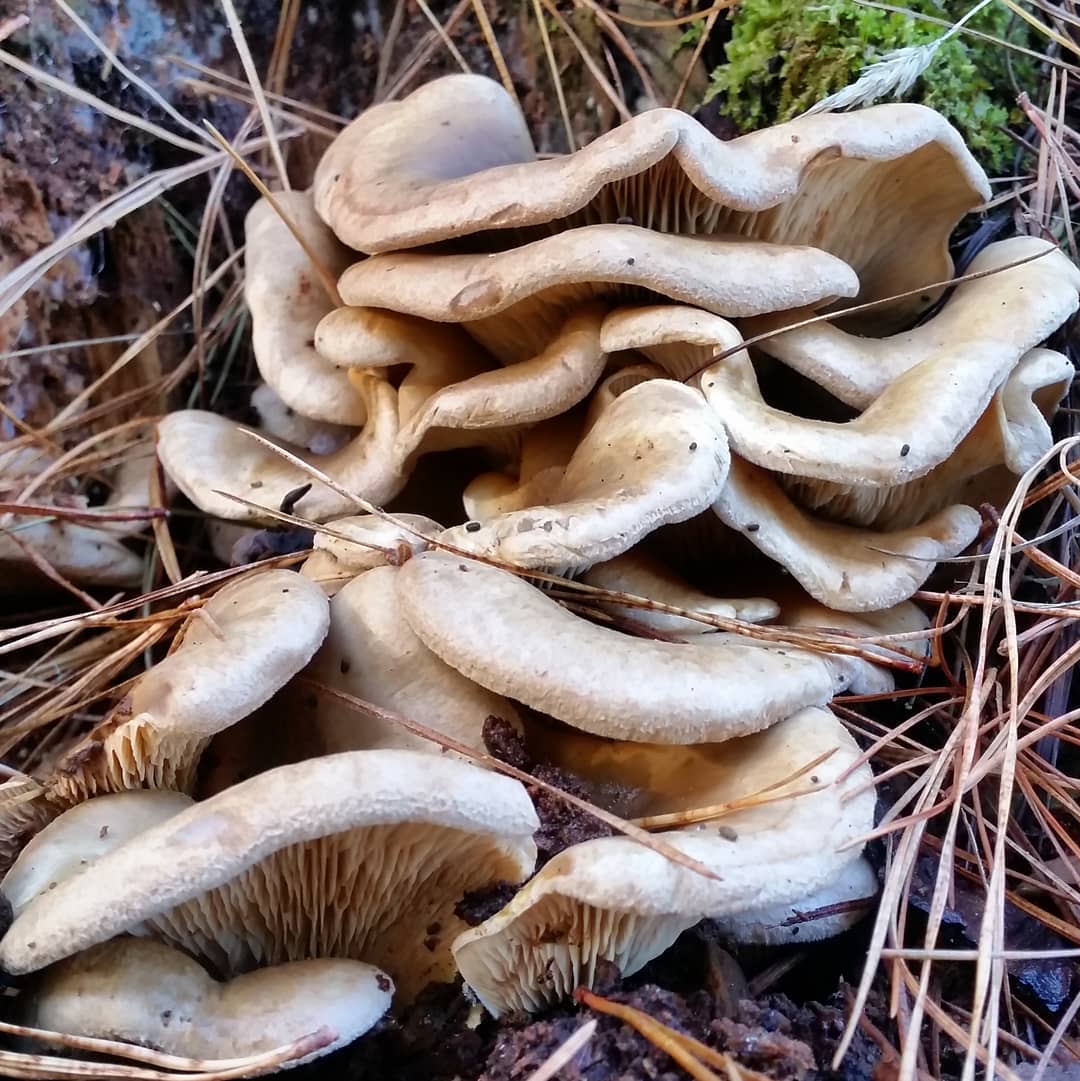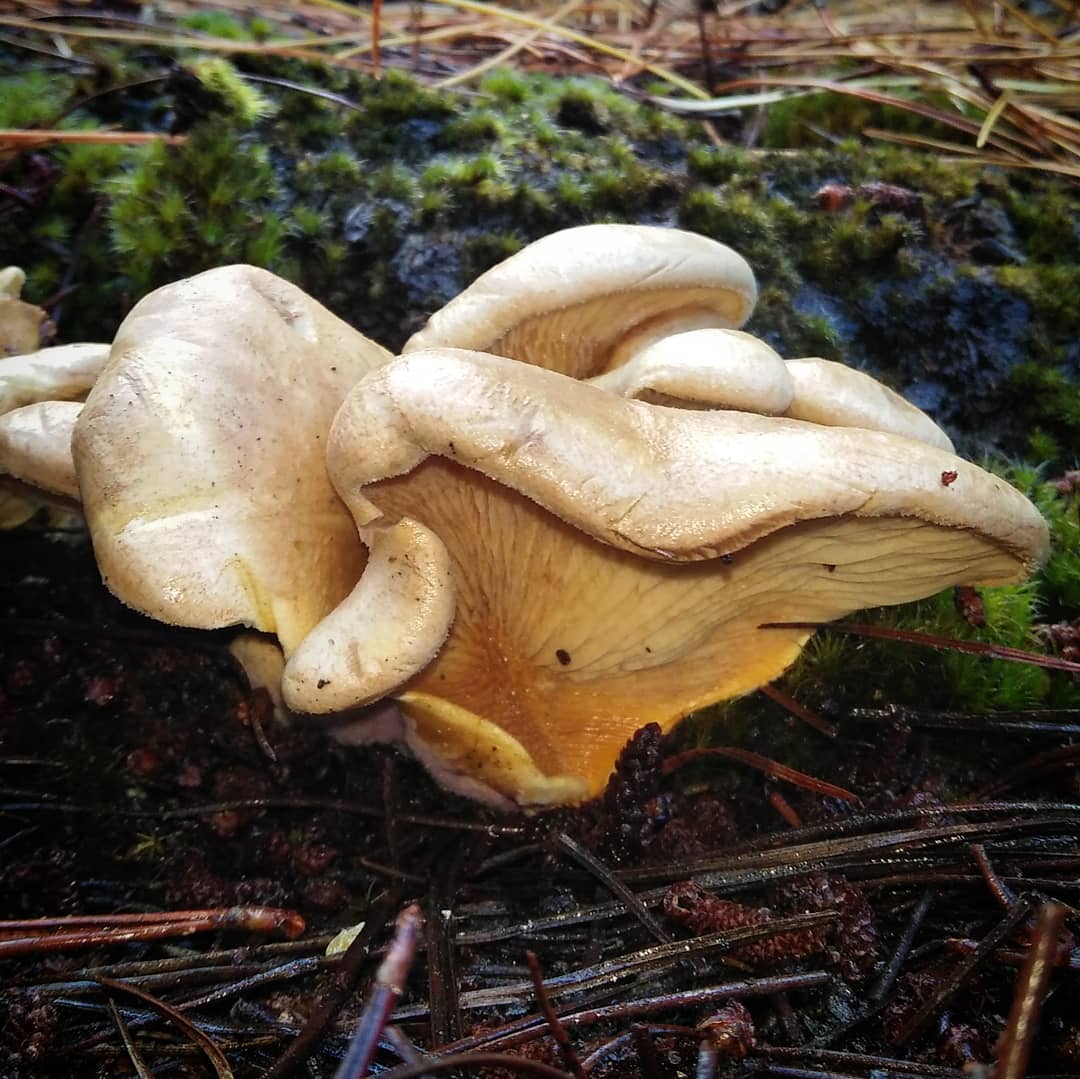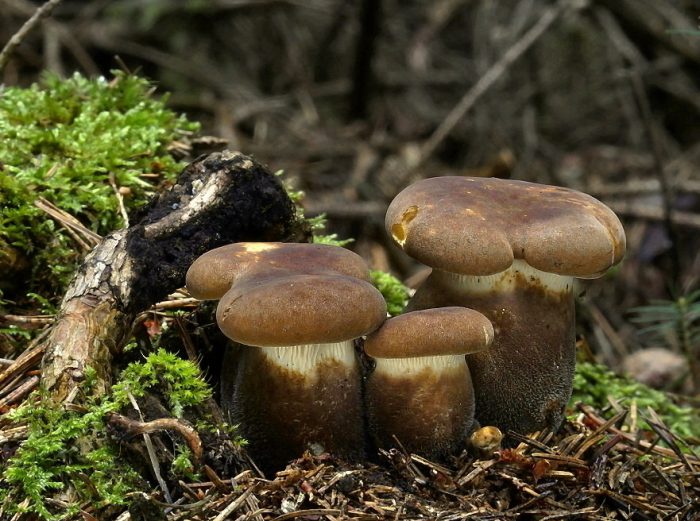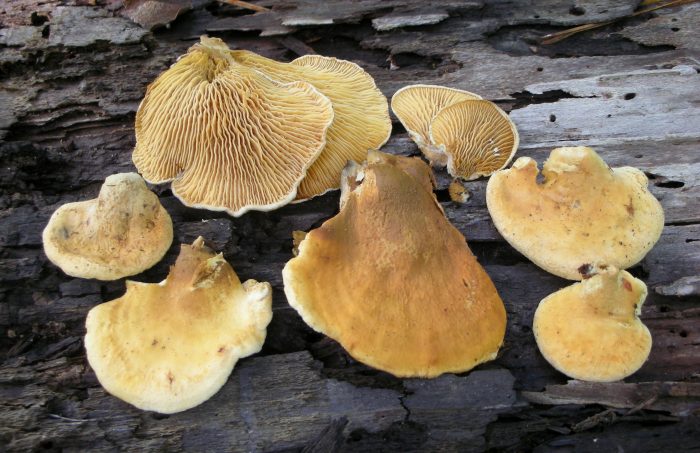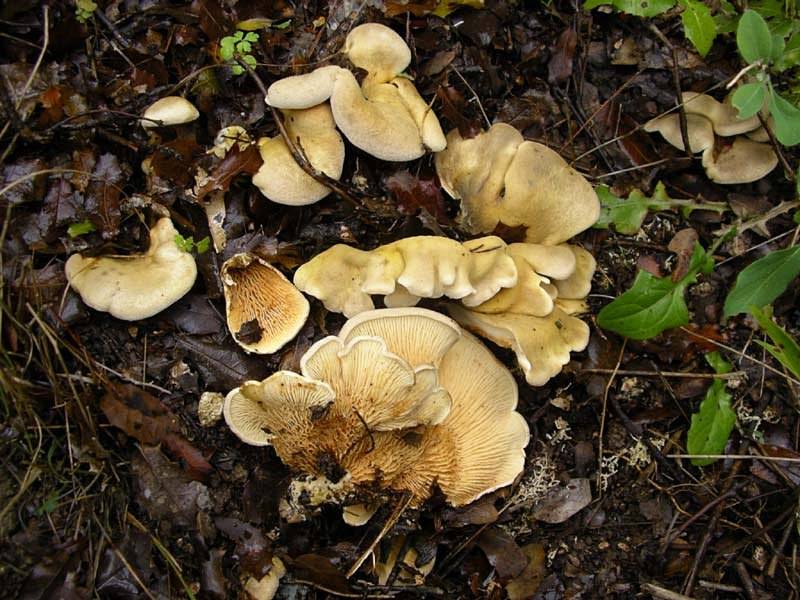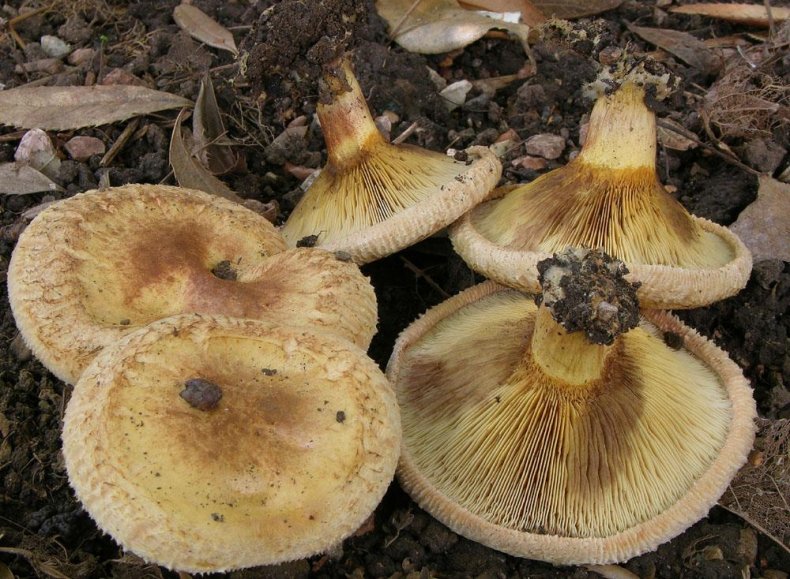Tapinella panuoides
- Other names for the mushroom:
- Ear-shaped pig
- Paxil panusoid
- Mine mushroom
- Pig underground
- Burial mushroom
Synonyms:
- Paxil panusoid;
- Mine mushroom;
- The pig is underground;
- Burial mushroom;
- Serpula panuoides;

Tapinella panuoides is a lamellar mushroom widespread in Kazakhstan and Russia.
External description
Panus-shaped tapinella is a fruiting body, consisting of a wide cap and a small, spreading out in the width of the leg. Most mushrooms of this type have almost no stem.
If the panus-shaped tapinella has a leg-shaped base, then it is characterized by high density, rubbery, dark brown or brownish in color, and velvety to the touch.
The tissues of the fungus are fleshy, have a thickness of 0.5-7 mm, a light brown or yellow-cream shade, when dried, the pulp becomes spongy.
The diameter of the mushroom cap varies from 2 to 12 cm, is fan-shaped, and sometimes shell-shaped. The edge of the cap is often wavy, uneven, and serrated. In young fruiting bodies, the surface of the cap is velvety to the touch, but in mature mushrooms it becomes smooth. The cap color of the panus-shaped tapinella varies from yellow-brown to light ocher.
The fungal hymenophore is represented by a lamellar type, while the plates at the fruiting body are narrow, located very close to each other, blown out near the base. The color of the plates is cream, orange-brown or yellow-brown. If you press on the plates with your fingers, it will not change its shade.
In young fruit bodies, the pulp is characterized by great rigidity, however, as it ripens, it becomes more lethargic, has a thickness of no more than 1 cm.On the cut, the pulp of the mushroom often becomes darker, and in the absence of mechanical action it has a dirty yellow or whitish color. The mushroom pulp has no taste, but it has a coniferous or resinous aroma.
The spores of the fungus are 4-6 * 3-4 microns in size, smooth to the touch, wide and oval in appearance, brown-ocher in color. The spore powder has a yellow-brown or yellow color.
Season and habitat of the mushroom
Tapinella panuoides belongs to the category of saprobic mushrooms that bear fruit from mid-summer to the very end of autumn. Fruit bodies are found both singly and in groups. This type of mushroom prefers to grow on coniferous litter or dead wood of coniferous trees. The fungus is widespread, often settles on the surface of old wooden buildings, provoking their decay.
Edibility
Panus tapinella is a slightly poisonous fungus. The presence of toxins in it is due to the presence of special substances in the composition of the fruit bodies - lectins. It is these substances that cause the clumping of red blood cells (red blood cells, the main components of blood).
Similar types and differences from them
The appearance of the panus-shaped tapinella does not stand out too much against the background of other fungi of this genus. Often this mushroom is confused with other varieties of lamellar mushrooms. Among the most famous varieties similar to the panus-shaped tapinella are Crepidotus mollis, Phyllotopsis nidulans, Lentinellus ursinus. For example, Phyllotopsis nidulans, in comparison with tapinella panusoid, prefers to grow on deciduous wood, has a rich orange cap. At the same time, the cap of this mushroom has even (and not serrated and wavy, as in the panus-shaped tapinella) edges. The mushroom Phyllotopsis nidulans does not have a very pleasant pulp aroma. The Crepidotus mollis fungus grows in groups, mainly on deciduous trees. Its distinctive features are less wrinkled plates, a cap of a light ocher hue (in comparison with tapinella panusoid, it is not so bright). The color of the fungus Lentinellus ursinus is pale brown, its cap is the same in shape as that of the panus-shaped tapinella, but its hymenophore is distinguished by narrow plates, located often. This type of mushroom has an unpleasant odor.
Other information about the mushroom
The etymology of the name of the fungus tapinella panus is interesting. The name Tapinella comes from the word ταπις, which means carpet. The epithet "panus-shaped" characterizes this type of mushroom as similar to Panus (one of the genera of mushrooms).
Paxil panusovidny (Tapinella panuoides)
- Other names for the mushroom:
- Tapinella panusoidnaya
- Ear-shaped pig
- Mine mushroom
- Pig underground
- Burial mushroom
Synonyms:
- Paxil panusoid;
- Mine mushroom;
- The pig is underground;
- Burial mushroom;
- Serpula panuoides;

Paxil panusovidny (Tapinella panuoides) is a lamellar mushroom, widespread in Kazakhstan and Russia.
External description
Paxil panus-shaped is a fruiting body, consisting of a wide cap and a small, spreading out in the width of the leg. Most mushrooms of this type have almost no stem.
If the panus-shaped tapinella has a leg-shaped base, then it is characterized by high density, rubbery, dark brown or brownish in color, and velvety to the touch.
The tissues of the fungus are fleshy, have a thickness of 0.5-7 mm, a light brown or yellow-cream shade, when dried, the pulp becomes spongy.
The diameter of the mushroom cap varies from 2 to 12 cm, is fan-shaped, and sometimes shell-shaped. The edge of the cap is often wavy, uneven, and serrated. In young fruiting bodies, the surface of the cap is velvety to the touch, but in mature mushrooms it becomes smooth. The cap color of the panus-shaped tapinella varies from yellow-brown to light ocher.
The fungal hymenophore is represented by a lamellar type, while the plates at the fruiting body are narrow, located very close to each other, blown out near the base. The color of the plates is cream, orange-brown or yellow-brown. If you press on the plates with your fingers, it will not change its shade.
In young fruit bodies, the pulp is characterized by great rigidity, however, as it ripens, it becomes more lethargic, has a thickness of no more than 1 cm.On the cut, the pulp of the mushroom often becomes darker, and in the absence of mechanical action it has a dirty yellow or whitish color. The mushroom pulp has no taste, but it has a coniferous or resinous aroma.
The spores of the fungus are 4-6 * 3-4 microns in size, smooth to the touch, wide and oval in appearance, brown-ocher in color. The spore powder has a yellow-brown or yellow color.
Season and habitat of the mushroom
Paxil panusovidny (Tapinella panuoides) belongs to the category of saprobic mushrooms that bear fruit from mid-summer to the very end of autumn. Fruit bodies are found both singly and in groups. This type of mushroom prefers to grow on coniferous litter or dead wood of coniferous trees. The fungus is widespread, often settles on the surface of old wooden buildings, provoking their decay.
Edibility
Panus tapinella is a slightly poisonous fungus. The presence of toxins in it is due to the presence of special substances in the composition of the fruit bodies - lectins. It is these substances that cause the clumping of red blood cells (red blood cells, the main components of blood).
Similar types and differences from them
The appearance of the panus-shaped tapinella does not stand out too much against the background of other fungi of this genus. Often this mushroom is confused with other varieties of lamellar mushrooms. Among the most famous varieties similar to the panus-shaped tapinella are Crepidotus mollis, Phyllotopsis nidulans, Lentinellus ursinus. For example, Phyllotopsis nidulans, in comparison with tapinella panusoid, prefers to grow on deciduous wood, has a rich orange cap. At the same time, the cap of this mushroom has even (and not serrated and wavy, as in the panus-shaped tapinella) edges. The mushroom Phyllotopsis nidulans does not have a very pleasant pulp aroma. The Crepidotus mollis fungus grows in groups, mainly on deciduous trees.Its distinctive features are less wrinkled plates, a cap of a light ocher hue (in comparison with tapinella panusoid, it is not so bright). The color of the fungus Lentinellus ursinus is pale brown, its cap is the same in shape as that of the panus-shaped tapinella, but its hymenophore is distinguished by narrow plates, located often. This type of mushroom has an unpleasant odor.
Other information about the mushroom
An interesting etymology of the name of the fungus is Paxil panus. The name Tapinella comes from the word ταπις, which means carpet. The epithet "panus-shaped" characterizes this type of mushroom as similar to Panus (one of the genera of mushrooms).
Pig "fat"
Such a mushroom is also popularly called a fat woman. Previous generations ate it salty. The "fat" pig loves to live on the stumps of coniferous trees, or on the roots. It appears at the beginning of the summer season and grows before the first snow falls. Pig mushroom has the following description:
- the hat can reach a diameter of almost 20 cm, is covered with a reddish-brown tint, yellowish plates, the shape of the hat is convex,
- the pulp is firm to the touch, golden tone, darkens at the break,
- the leg is brown, short, often curved, covered with villi along its entire length.
Today, the "thick" pig mushroom is considered poisonous. Its pulp, even when salted, is harsh and bitter. Such pigs were harvested and eaten only in hungry years.
Eating
The fat pig is usually classified as conditionally edible mushrooms. The fruit bodies of Tapinéllaatrotomentósa can be used for food purposes after pre-boiling and subsequent frying. Undoubtedly, a fat pig is a mushroom low food quality and is currently ranked among the mushrooms of unexplored toxic effects on the human body.

Before frying or closing a thick pig in jars, it is necessary to thoroughly clean the collected fruit bodies from forest debris and soil contamination. Then, the mushrooms are washed several times in running water and boiled twice with the removal of the mushroom broth, which should not be used for cooking.
Most often, pre-boiled mushrooms are used for home canning, as well as for preparing hot dishes, including pigs fried in sour cream sauce. It should be noted that 100 g of such a dish contains:
- proteins - slightly less than 3 g or 3.6% of the daily value;
- fat - 5.5 g or 8.6% of the daily value;
- carbohydrates - 3.5 g or 1.5% of the daily value;
- dietary fiber - 3 g or about 15% of the daily value;
- sodium - just over 5.0 mg, or about 0.4% of the daily value;
- water - 84.0 g or 3.5% of the daily value.

Fat pig (lat.Tapinella atrotomentosa)
The most common types of pigs include both thin pig and fat pig. This is a mushroom of the Tapinella family of the order Boletovye. The mushroom has a cap with a diameter of 5-15 cm, first convex, hemispherical, and later lingual with a funnel-shaped depression in the center. The surface of the cap is velvety or smooth with a rusty brown color. The edges are tucked up. On the underside, it has a frequent lamellar layer of creamy color in young mushrooms and brown in mature ones. The leg is about 7 cm high and up to 3.5 cm in diameter, cylindrical, can be mounted centrally or laterally.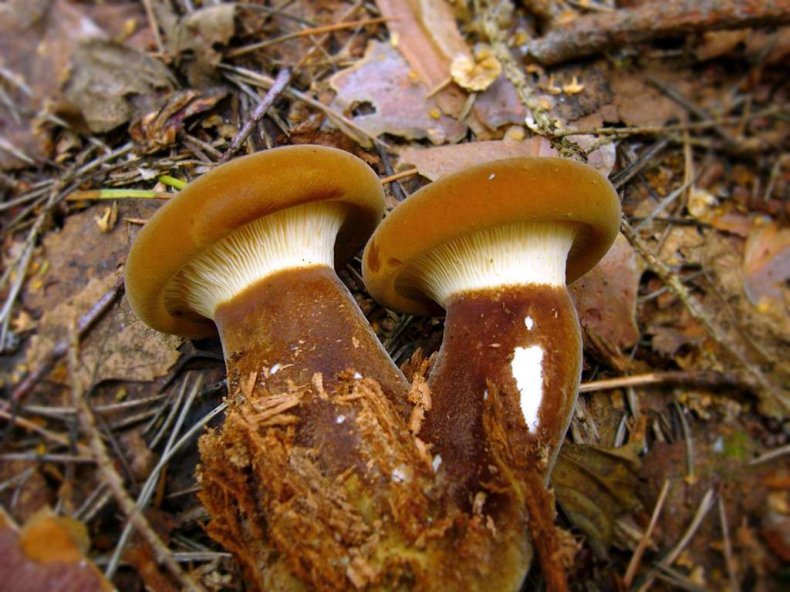
Its surface is velvety, dark brown in color. It is often completely immersed in the substrate. The pulp of the mushroom is whitish-yellow in color without a special smell with a bitter taste. It has the ability to swell in the presence of moisture and darkens at the break. Spore powder of mushrooms of yellow-brown color.
Ammonia stains the flesh of a thick pig in a bright lilac color, and potassium hydroxide (KOH) - green-black.
The fat pig belongs to conditionally edible mushrooms.Abroad, it is considered inedible or with unexplored toxic properties.
The pulp of these mushrooms contains atromentin (a brown pigment), which acts as an antibiotic and has an antitumor effect, telephoric acid (a blue pigment), which is used to dye wool blue.
Characteristic features of the variety
The Svinushkov family belongs to the poisonous and conditionally edible. Therefore, for an inexperienced mushroom picker who has not studied all the nuances and features of pigs from the photo and description, it is better to bypass these mushrooms.
Appearance and structure
The pig has not only several varieties, but also other names: dunka, pig, cowshed, pig's ear, salt. Medium-sized mushrooms, regardless of the species.
By structure, they are lamellar, usually the plates are light brown or yellow. The color of the top of the cap is from light beige to brown. The leg, depending on the type, can be thin and high or thick and short, and also completely absent
Therefore, it is so important to determine by the appearance of the pig's belonging.
You may be interested in:
Place of distribution
Piggies grow in many locations: deciduous forests and conifers, thickets of bushes, edges, edges of swamps, places with fallen trees. At the same time, they grow up in "families", "witch circles". Bear fruit abundantly.
Eating
The edible mushroom or not depends primarily on the species, but the place of growth also matters: for example, poisonous neighbors are quite capable of transferring their properties to an edible mushroom growing nearby. A thin pig should not be eaten under any circumstances, a fat pig can only be eaten after a long boil, although it has very low taste, so real gourmets ignore it.
Mushroom roe from pigs
There is another good recipe for preparing this product for the winter - mushroom caviar. It will require:
- boiled pigs - 2 kg;
- onions - 4-5 pcs.;
- two carrots;
- three tomatoes;
- three cloves of garlic;
- Bulgarian pepper - 1/2 kg;
- sunflower oil - 150 g;
- sugar - 20 g;
- salt - 30 g;
- vinegar.
Ready boiled pigs, bell peppers and tomatoes are scrolled through a meat grinder. How to cook pig mushrooms has been described in detail above. Onions and grated carrots are fried in sunflower oil. After that, all the ingredients are mixed with a blender into a homogeneous mass and laid out in a stewing container. Salt and sugar are added here, and all this is stewed for an hour. The caviar must be constantly stirred. Chopped garlic is added 15 minutes before the end of cooking, and vinegar is added 1-2 minutes before it is fully cooked. Hot caviar is laid out in jars and rolled up with lids.
Filly mushrooms how to cook
How to cook deliciously fried pig mushrooms with potatoes
Fortunately, the recipes for making fried pigs did not end there. So, many housewives like to combine them with potatoes - this is both the side dish itself and a delicious addition to it. The dish turns out to be appetizing and very satisfying; it can be found very often on the table of Russian families.
- Pigs - 0.6 kg;
- Potatoes - 0.4;
- Onions - 2 pcs.;
- Vegetable oil;
- Salt pepper.
How to fry pigs with potatoes in order to prepare a full lunch or dinner from this combination?
- Prepare the mushrooms for frying in the way mentioned at the beginning of the article.
- Peel the potatoes, cut them into cubes or slices, put them in water and leave for 20 minutes to remove the starch.
- Meanwhile, pour oil into the pan and put the prepared pigs there.
- Fry for 10 minutes and add the onion, cut into half rings, and continue to fry for another 5 minutes.
- Dry the sliced potatoes with a kitchen towel and add to the mushrooms, fry until tender with the lid open.
Is the pig a poisonous or edible mushroom?
For the first time, they started talking about the toxic properties of pigs in October 1944, when the German mycologist Julius Scheffer ate these mushrooms.After that, he felt unwell, vomiting, diarrhea and high fever appeared. He died 17 days later of acute renal failure.
Here's what you need to know about pigs:
- The pigs contain special toxins (lectins) that do not lose their properties even after repeated heat treatment. A slender pig is capable of synthesizing a very dangerous poison called muscarine, which is equivalent in toxicity to the poison of a red fly agaric.
- Studies have found that pigs contain a special antigen that binds to the structures of cell membranes. The human body recognizes these cells as hostile and attacks its own cells, in which the pig antigens are located. As a result of this process in the human body, red blood cells are damaged, this leads to hemolytic anemia, and then to the development of nephropathy and renal failure. Antibodies are produced over time, so liver damage may not be immediately apparent.
- Pig mushrooms accumulate large amounts of heavy metals, as well as radioactive isotopes of copper and cesium, which in themselves can cause severe poisoning of the body.
- Also, eating pigs in food threatens a person with allergic reactions.
Dangerous doubles
In many foreign sources, piggy is reasonably considered an inedible mushroom or refers to fruits with toxic components that have not yet been studied. In Russia, it is still classified as conditionally edible. It is not difficult to distinguish felt mushrooms, their individuality is quite pronounced.
| Name | Hat and leg | Hymenophore | Danger |
The pig is fat |
The hat is brown with a brown tint, the leg is much darker, very thick, often located on the side | Lamellar, honey, yellowish | Conditionally edible |
The pig is thin |
The hat is always olive-tinted, the leg is much lighter, located in the center | Lamellar, brown with a yellow or rusty tinge | Poisonous |
Polish mushroom |
The hat is chestnut, convex, the leg is light brown, with red-brown vertical stripes-fibers | Tubular | Edible |
Flywheel green |
The pillow-shaped cap is grayish or brown in color, located on a rather thin stem, which is covered with a brown mesh | Tubular | Edible |
The greatest danger lies in wait if you confuse the felt pig with a thin sister. You should very carefully pick mushrooms in the forest, in no case take dubious specimens into the basket.
Differences between a pig thin and thick
A detailed comparison of two related and very similar pigs is presented in the table. It is difficult to distinguish them even for experienced mushroom pickers.
| Name | Felt pig |
Slim Pig |
| Hat | Brown or brown, velvety, often cracks when ripe, the center has a depression | Brown with olive, grayish or rusty tint. Dry, fluffy, sticky in the rain. Slightly convex at first, then flat |
| Leg | Thick, short, much darker than the cap, often shifted to the side, felt surface | Short, thin, matte, gray-yellow or olive, much lighter than the cap, less often the same color |
| Hymenophore | Yellowish, descending the leg, darkened by touch | Pseudo-lamellar, the layer extends from the bottom of the cap. The color is brown with a yellow or rusty tinge, darkens when pressed |
| Pulp | Bitter, no smell, yellow, watery | Soft, odorless and tasteless, usually wormy in dry weather |
| Danger | Edibility is not fully understood, but cases of poisoning have been recorded | The toxins contained in the mushroom after cooking do not disappear, many deaths have been recorded, cannot be eaten, it is poisonous |
Often, a slender pig causes allergies, accumulates a large amount of heavy metals and gradually unbalances all body functions. German mycologist Julius Schaeffer was the first to die from eating this mushroom in 1944.
The main difference is still in the leg
When harvesting, you should pay special attention to it.
Pig mushrooms: photo and description
Pigs are small mushrooms that look a little like a lump in appearance. The thick and fleshy head of the pig has a rounded or elongated-rounded shape. On average, its sizes vary from 120 to 150 mm, however, there are mushrooms in which the diameter of the cap reaches 200 mm. In a young mushroom, its upper surface is slightly convex, but as it matures, it flattens and becomes concave, with a wavy edge tucked down.

The color of the pig's cap can be olive, yellowish-brown, reddish-brownish, or gray-brown. Its tone and intensity changes with age, moving from lighter tones to darker ones. The underside of the cap is grayish-white with a slight yellow or reddish-brown tint. The pulp is dense, pale yellow in color, darkening at a break or cut. The surface of the cap is rough and dry, however, it becomes sticky after prolonged rains.
The stem of the mushroom is small, its length rarely exceeds 9 cm, and its diameter is 2 cm. The color of the stem practically does not differ from the color of the cap. Usually pig mushrooms grow in small groups.
Pig mushroom caviar
There are many ways to prepare pigs for edible mushrooms. For example, you can make delicious and flavorful caviar that will help you out with quick snacks. In addition, it can be used to stuff dough products: tartlets, pies, pancakes, pies, pizzas, etc.
- Pigs that have undergone primary processing - 700 g;
- Carrots, onions and bell peppers - 2 pcs.;
- Garlic - 2-4 cloves;
- Tomato paste - 1-2 tbsp l .;
- Vegetable oil - for frying;
- Sugar, salt, pepper.
The next steps will show you how to cook a thick pig in the form of mushroom caviar.
- Fry the peeled and boiled mushrooms in a pan until the liquid evaporates, transfer to a deep bowl. You can also take frozen fruit bodies for cooking, but they must be defrosted in a natural way, transferring them from the freezer to the refrigerator overnight.
- Cut carrots, onions and peppers into cubes and fry in vegetable oil until tender.
- Combine vegetables with mushrooms, interrupt with a blender or mince.
- Put the resulting mass into a deep dish with a thick bottom, add garlic passed through a press, tomato paste, salt, sugar and pepper to taste, mix.
- Simmer caviar over low heat for 30-35 minutes, then put in glass jars.
- If you want to prepare roe from pigs for the winter, add 1 tbsp at the end of cooking. l. 9% vinegar, and then spread the mass into sterilized jars and sterilize again for 20 minutes, but this time together with the workpiece.
- Close the jars with tight plastic lids or roll up metal ones.
Paxillus vernalis pig mushrooms
The fungus is found in the mountain forests of North America, Estonia, Great Britain, Denmark. Forms a symbiosis with aspen and birch. The fruiting period is August - October. The hat is convex, it can have various shades of yellow-brown color. Its surface can be smooth or slightly rough. There are yellow plates under the cap. The pulp of the mushroom is fleshy, dense, without a pronounced odor. Its yellow color changes to reddish brown at the break. The leg is up to 9 cm high, 2-2.5 cm in diameter, the color matches the color of the cap.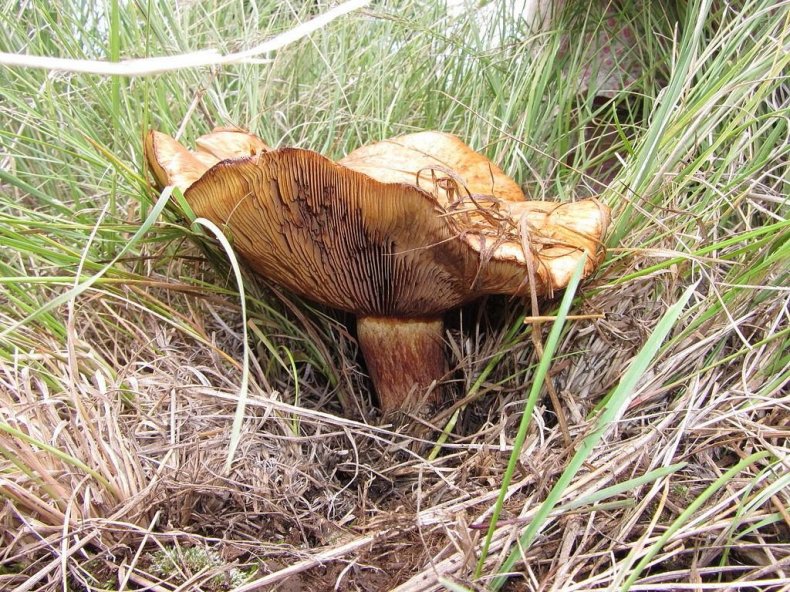
Important! Slender Pig synthesizes muscarine. This is a dangerous poison, which is equal in toxicity to the poison of a red fly agaric.
It is not destroyed during the boiling of the mushrooms.
Eating pigs can cause a violent, fatal allergic reaction. Therefore, before eating one of the types of pigs, you need to make a choice for yourself - to risk your life or not. What is more dear to you - the taste of pigs or life, decide for yourself.
The pig is thin: photo and description
Mushroom Pig in the photo
Pig is a lamellar mushroom that grows in various types of forests in large groups, from July to October, it can form mycorrhiza.In recent years, the pig has been classified as a poisonous mushroom (it can cause poisoning, even fatal). It contains substances that lead to a decrease in red blood cells in the blood. Moreover, the manifestation of poisoning depends on the individual characteristics of the human body and can occur both a few hours later and several years after the use of these mushrooms.
Previously, the pig was considered an edible mushroom, it was even taken into government procurements. In all the old books, it is designated as an edible mushroom. Currently, views on her have changed. It turned out that the pig contains an antigen that causes the production of antibodies by the human immune system. Moreover, the effect of this antigen on the body depends on the susceptibility of each person. For some, excessive antibody production may occur, resulting in allergic shock. Signs of poisoning may appear after a few hours or several years, since the toxin can accumulate in the body. Kidney function is impaired, which can lead to death. Treatment is to maintain kidney function.
Further you can familiarize yourself with the photo and description of the mushrooms of different types of pigs.
The pig is thin in the photo
The slender pig (Paxillus involutus) is a lamellar mushroom, in some sources referred to as a pig's ear or dunka. Grows singly, in small groups or in numerous colonies from mid-June to early November, easily tolerating the fall in temperature. Grows in deciduous, mixed and coniferous forests, parks and gardens. In autumn, in the willow groves, you can find a lot of pigs.
Favorite habitats are wet areas of soil in lowlands and near swamps, woodlands, parks, vegetable gardens, as well as fallen tree trunks.
The mushroom is considered poisonous.
The cap is 5-15 cm in diameter, in young specimens it is convex, fleshy, light olive or greenish-beige, with a strongly tucked edge, with dense, thick light pulp, then open, with a depressed center, yellow-brown or gray-brown ...
The plates are descending, soft, branched, yellow-buffy.
As you can see in the photo, a thin pig has a cylindrical leg, thinned downwards, 3-8 cm long and 1-2 cm thick, velvety, of the same color with a cap:
The pulp is thick, soft, elastic in young mushrooms, loose, pale brown in mature ones, brown in old mushrooms, darkens on the cut. The smell of the pulp is pleasant, the taste is sour.
Fruiting from July to November.
Until the early 80s of the last century, the slender pig was considered an edible mushroom, but after cases of mass poisoning were noted in several countries at once, doctors unanimously attributed it to the category of poisonous. It turned out that as a result of the frequent consumption of this variety of pigs in the human body, there is an accumulation of antibodies that destroy red blood cells. This, in turn, leads to serious kidney problems. In addition, it turned out that the slender pig easily accumulates heavy metals in its tissues, which also have a destructive effect on the human body.
According to the description, this pig cannot be confused with other mushrooms.
Preliminary preparation of mushrooms
Take full responsibility for the pre-processing of special mushrooms, do not ignore this procedure.
- Pigs cannot simply be rinsed, boiled once, and eaten. The mushrooms have come to your home - immediately start preparing them for further culinary manipulations.
- On pigs, dirt and debris often accumulate, leaves stick. If you can't remove all this with your hands, soak the mushrooms in water for half an hour.
- Place the mushrooms in a container of cold, salted water to cover completely for at least five hours.
- Rinse them and repeat the soaking procedure.
- Divide the large mushrooms into 2-3 parts, leave the small ones intact and put everything in a pot of water, which you put on the stove. Boil mushrooms for half an hour and drain.
- Rinse the product and repeat the procedure.This time add salt to the water (for 1 kilogram of pigs, 1 teaspoon of salt). After half an hour, drain the water again, rinse the mushrooms and cook them again according to the same principle.
- Throw the finished mushrooms in a colander and let the water drain.
- Ready! Now the pigs can be fried, frozen, stewed - do with them what you want.
- It is recommended to boil the mushrooms at least twice for half an hour, but it is better not to be lazy and do it at least three times - you will be healthier.
The pig is fat
This variety is popularly called the felt pig. The scientific name for stout pig is Tapinéllaatrotomentósa. This type of mushroom belongs to the genus Tapinella or Tapinella and the family Tapinella or Tapinellaceae. The difference between this mushroom cap is the following characteristic and description of the appearance:
- the diameter of a convex or hemispherical cap is about 5-25 cm;
- the central part of the cap is depressed, and the edges are turned up and fleshy;
- the surface is characterized by velvety and staining in a rusty-brown or ocher-brown color;
- the leg is relatively high and thick; it is immersed in the soil substrate, cylindrical or expanding at the bottom;

- the surface of the leg is of a woolly velvety type, dark brown or almost black in color;
- the color of the flesh can range from whitish to ocher, with a characteristic darkening on exposure to air;
- the pulp is characterized by the absence of a pronounced mushroom smell, and sometimes the presence of a bitter taste.
To prevent the collected mushrooms from changing color during heat treatment, it is necessary to add a small amount of salt or vinegar to the water. Among other things, in order to protect yourself, it is recommended to soak the fruit bodies of a fat pig several times, periodically changing the water, and then boil the mushrooms and marinate.








